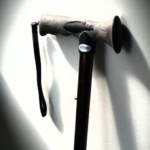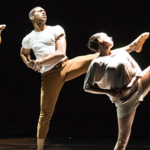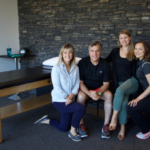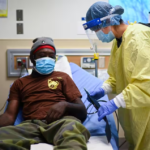Conservative biomechanical strategies for knee osteoarthritis
Knee osteoarthritis (OA) is one of the most prevalent forms of this disease, with the medial compartment most commonly affected. The direction of external forces and limb orientation during walking results in an adduction moment that acts around the knee, and this parameter is regarded as a surrogate measure of medial knee compression.
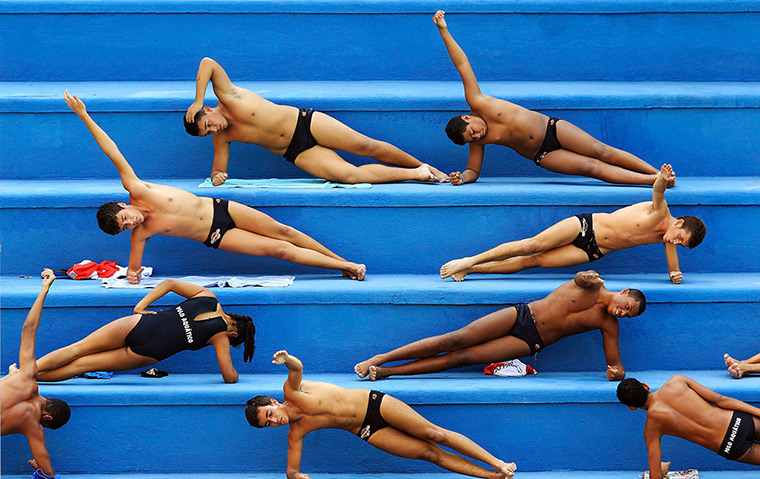
São Paulo, Brazil: Water polo players warm up during training. Paulo Whitaker, Reuters in The Guardian
By Neil D. Reeves PhD and Frank L. Bowling PhD, Medscape Multispecialty CME Released 02/02/2012
| Key points. |
- Knee osteoarthritis (OA) is closely associated with the development of a high external knee adduction moment, which reflects compression of the medial compartment of the knee
- The nature of biomechanical loading at the knee joint can be altered by a number of conservative intervention strategies, which are potentially capable of slowing the progression of the disease
- Using lateral wedge insoles or thin-soled, flexible shoes can reduce the knee adduction moment and thus contribute to retarding the progression of OA
- Strategies that directly modify gait characteristics, such as a toe-out gait, lateral trunk lean and the use of a walking stick, can reduce the knee adduction moment
- Intervention strategies that act either directly or indirectly upon the knee joint, such as valgus knee braces and muscle strengthening, can effectively decrease the knee adduction moment
The knee adduction moment is intimately linked with the development and progression of knee OA and is, therefore, a target for conservative biomechanical intervention strategies, which are the focus of this review. We examine the evidence for walking barefoot and the use of lateral wedge insoles and thin-soled, flexible shoes to reduce the knee adduction moment in patients with OA.
We review strategies that directly affect the gait, such as walking with the foot externally rotated (‘toe-out gait’), using a cane, lateral trunk sway and gait retraining. Valgus knee braces and muscle strengthening are also discussed for their effect upon reducing the knee adduction moment.
The medial tibiofemoral compartment of the knee is most commonly affected by OA and this predilection probably reflects the loading experienced during daily locomotor activities.

| Figure 1. The external knee adduction moment during walking. The magnitude and direction of the GRF are shown by the height and direction, respectively, of the straight arrows. The length of the MA of the GRF acting about the knee joint is indicated by dotted red lines. |
| A | The knee adduction moment increases if the length of the MA increases, or the GRF magnitude increases, or both. |
| B | A varus knee deformity (dark-shaded leg) is superimposed over a neutrally aligned knee (light-shaded leg). In the varus-aligned knee, the center of pressure (indicated by the origin of the GRF vectors) has shifted in the medial direction, increasing the MA of the GRF and, therefore, the knee adduction moment. |
| C | Lateral wedge insoles shift the center of pressure, causing the GRF to pass closer to the knee joint center (assuming the GRF angle remains constant). This effect decreases the MA of the GRF about the knee and reduces the knee adduction moment compared with the situation without lateral wedge insoles. Abbreviations: GRF, ground reaction force; MA, moment arm. |
| Reeves ND, et al. 2011 Nature Reviews Rheumatology |
The integral role of biomechanical factors in the development and progression of OA, especially of the lower limb, is becoming widely acknowledged. Throughout the entire stance phase of walking, an external adduction moment acts around the knee joint, which tends to rotate the tibia medially with respect to the femur in the frontal plane (Figure 1a). This external knee adduction moment is primarily caused by a medially acting ground reaction force, which is present during level walking and other loco-motor paradigms, such as stair negotiation (Figure 1a).
The magnitude of the knee adduction moment is influenced by the magnitude of the ground reaction force, the moment arm of the ground reaction force about the knee joint center (defined as the perpendicular distance between the action line of this force and the knee’s center of rotation), and the mass and acceleration of lower limb segments (Figure 1a). A high knee adduction moment reflects increased compressive forces acting on the medial aspect of the knee and is widely regarded as a surrogate measure of medial knee compression.
Varus knee alignment (Figure 1b) has been reported as one of the best predictors of a high knee adduction moment. Studies in patients with OA have calculated the coefficient of correlation as 0.52, 0.61 or 0.75 between varus knee alignment and the peak knee adduction moment during walking. In line with this association, patients with moderate-to-severe OA show an increased varus knee alignment of between 2° and 6° compared with patients with mild to moderate symptoms. In patients with a high preoperative knee adduction moment (but not those with a low preoperative knee adduction moment), the re-emergence of a varus deformity ~5 years after proximal tibial osteotomy to achieve a valgus correction underlines the central role of high knee adduction moments in both the development and progression of knee OA. Indeed, a high knee adduction moment is a very strong predictor OA progression.
The evidence unequivocally suggests that high knee adduction moments are intimately linked with the severity of medial knee OA, although a causal relationship might be difficult to establish. Patients with medial knee OA demonstrate considerably higher knee adduction moments during walking compared with matched controls.
The magnitude of the knee adduction moment discriminates most strongly between patients with moderate-to-severe OA and controls, whereas patients with mild OA demonstrate slightly less marked differences in knee adduction moment compared with controls. Patients with severe knee OA, identified on the basis of radiographic disease severity (Kellgren-Lawrence grades 3-4) display higher knee adduction moments than do those with mild OA (Kellgren-Lawrence grades 1-2).
| Neil D Reeves is a Postdoctoral researcher, Institute for Biomedical Research Into Human Movement & Health, Manchester Metropolitan University, Manchester UK & Bowling, FL, Faculty of Medical & Human Sciences, University of Manchester, Central Manchester University Teaching Hospital, Manchester UK |
Source Medscape Multispecialty
| References |
Reeves-Bowling-2011-Nature-Rev-Rheumatol
Conservative biomechanical strategies for knee osteoarthritis, Reeves ND, Bowling FL. Nat Rev Rheumatol. 2011 Feb;7(2):113-22. doi: 10.1038/nrrheum.2010.212.


